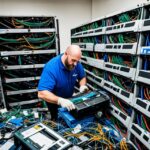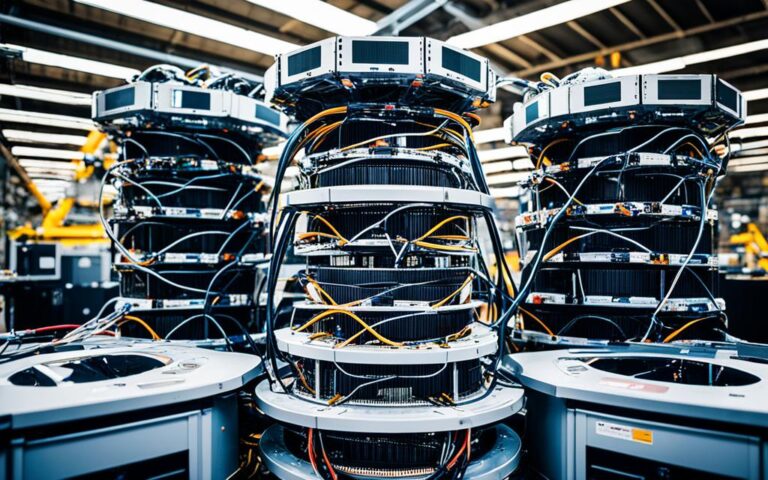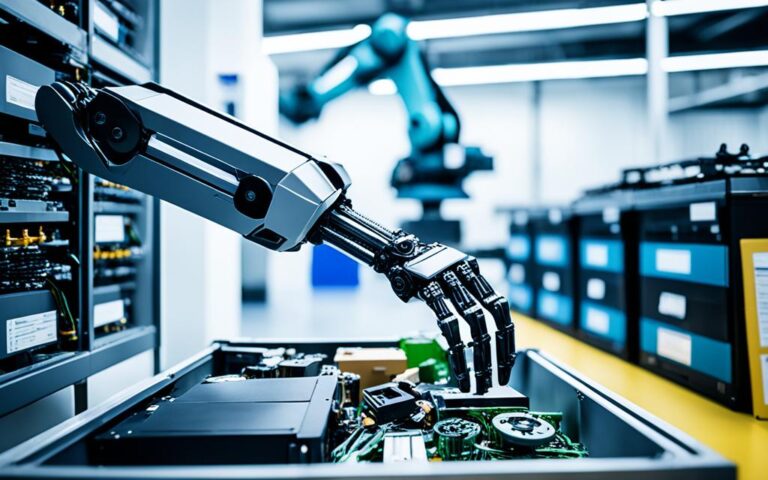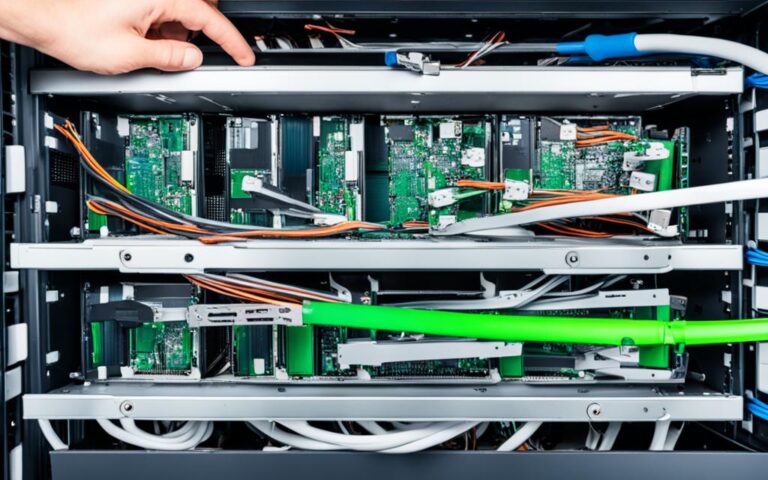How Server Recycling Contributes to the Circular Economy
In today’s rapidly advancing technological landscape, the sustainable management of servers and data centers plays a crucial role in shaping a greener future. Embracing the principles of the circular economy, which aims to eliminate waste and pollution while promoting the regeneration of nature, is key to achieving sustainability in the technology industry.
Server recycling is a vital component of the circular economy, allowing data centers to reduce their environmental impact and contribute to a more sustainable world. By prolonging the life cycle of servers and other equipment, data centers can minimize the need for raw materials and limit electronic waste.
Through responsible server recycling, outdated and decommissioned servers can be refurbished, repurposed, or recycled, ensuring their materials are returned to the production cycle rather than ending up in landfills. This not only conserves valuable resources but also reduces the carbon footprint associated with mining and manufacturing new equipment.
By adopting server recycling practices, data centers can actively contribute to the circular economy, promoting a more sustainable and eco-friendly approach to technology. This not only aligns with corporate social responsibility goals but also enhances the overall efficiency and performance of data centers.
Join us as we delve deeper into the principles of the circular economy and explore how adopting a circular economy model in data centers can drive positive environmental change.
The Principles of a Circular Economy
The core principles of a circular economy involve eliminating waste and pollution, circulating products and materials, and regenerating nature. In a linear economy, materials are used to create products that are eventually discarded, leading to waste and pollution. However, in a circular economy, the goal is to remove waste from production and extend the lifespan of products and materials.
One of the key components of a circular economy is reuse and refurbishment. Instead of disposing of products, they are repaired, upgraded, or repurposed for further use. This not only reduces the amount of waste generated but also prolongs the life of the product.
Composting and natural recycling are also important practices in a circular economy. Composting allows organic materials to break down naturally and become nutrient-rich soil, which can be used to regenerate nature. Natural recycling refers to the process of returning materials to their original state in a natural ecosystem, creating a closed loop of resource utilization.
A circular economy aims to build sustainable systems that reduce waste, keep materials in use for longer, and promote the healing of nature. By adopting these principles, businesses and industries can contribute to a more sustainable and environmentally friendly future.
Benefits of a Circular Economy
Implementing a circular economy brings several benefits:
- Reduced waste and pollution: By eliminating waste and designing products for reuse, the amount of waste and pollution generated is significantly reduced.
- Conservation of resources: By circulating products and materials, fewer resources need to be extracted from the environment, preserving natural resources.
- Job creation: The shift towards a circular economy creates new job opportunities in areas such as repair, refurbishment, and recycling.
- Economic growth: A circular economy can stimulate economic growth by promoting innovative business models and creating new markets for reused and repurposed products.
- Improved environmental sustainability: By regenerating nature through practices like composting and natural recycling, a circular economy contributes to the overall health and sustainability of the environment.
Adopting a Circular Economy Model in Data Centers
To successfully transition to a circular economy model, data centers can implement several strategies that contribute to a more sustainable future. By adopting these practices, data centers can minimize their environmental impact and promote a circular economy in the technology industry.
Education and Policies
One of the key steps in adopting a circular economy model is providing access to education and establishing policies and workflows that support sustainable practices in data centers. By educating employees and stakeholders about the importance of circular economy principles, data centers can create a culture of sustainability.
Minimizing Mining of Raw Materials
Data centers heavily rely on server, storage, and networking equipment, which are often composed of critical materials. To minimize the mining of these raw materials, data centers can opt for remanufactured, refurbished, or used equipment whenever possible. By extending the lifespan of existing equipment, data centers can reduce the demand for new materials and contribute to a circular economy.
Transition to Renewable Energy
Reducing greenhouse gas emissions is essential for a sustainable future. Data centers can make a significant impact by transitioning to renewable energy sources, such as solar or wind power. This shift not only decreases the carbon footprint but also demonstrates a commitment to sustainable practices.
Reuse Heat and Water
Data centers generate a significant amount of heat, which can be reused to heat nearby buildings or provide thermal energy for other purposes. By implementing innovative methods to reuse heat, data centers can minimize energy waste and contribute to a circular economy. Additionally, data centers can adopt water-saving technologies and practices to curb water consumption and conserve this precious resource.
Conduct Lifecycle Assessments
To evaluate the environmental impact of the production process, data centers can conduct lifecycle assessments. These assessments help identify areas where sustainability improvements can be made, enabling data centers to make informed decisions about equipment procurement and resource management.
Improving Longevity and Proper Disposal
Data centers can enhance the longevity of equipment through predictive maintenance and regular inspections. By implementing proper disposal practices for obsolete IT equipment, data centers can ensure responsible e-waste management and reduce environmental harm.
Adopting Newer Digital Technologies
The use of newer digital technologies, such as virtualization and cloud computing, can enhance environmental efficiency in data centers. These technologies optimize resource utilization and reduce energy consumption, contributing to a more sustainable operation.
Partnerships with Values-Aligned Vendors and Organizations
Collaborating with values-aligned vendors and organizations allows data centers to participate in circular-economic initiatives. By aligning themselves with partners who share their commitment to sustainability, data centers can exchange knowledge, resources, and best practices, furthering the progress towards a circular economy.
Adopting a circular economy model in data centers requires a holistic approach that involves education, policy changes, renewable energy, resource optimization, and partnerships. By embracing these strategies, data centers can play a significant role in promoting sustainability and paving the way for a more eco-friendly technology industry.
Real-world Data Center Circular Economy Practices
Major technology companies like Microsoft, Amazon, and Google are leading the way in implementing circular economy practices in their data centers. These industry giants understand the importance of sustainability and are committed to making a positive environmental impact. Let’s take a closer look at the circular economy practices of these companies:
Microsoft
Microsoft is dedicated to reusing and repurposing its cloud computing hardware assets. The company has set an ambitious goal of reusing 90% of its hardware by 2025. To achieve this, Microsoft has established circular centers that process decommissioned servers and hardware components. These circular centers ensure that valuable resources are not wasted but instead put back into circulation, reducing the need for new production and minimizing environmental impact.
Amazon
Amazon takes a comprehensive approach to circularity in its data centers. The company operates reverse logistics hubs, where hardware from local data centers is either fixed or demanufactured for reuse in other data center hardware. By refurbishing and redistributing components, Amazon maximizes the lifespan of its equipment and reduces waste. This commitment to circular economy principles allows Amazon to minimize its environmental footprint while maintaining operational efficiency.
Google is another tech giant committed to circular economy practices. The company has achieved impressive results, with several of its data centers boasting zero waste to landfill. Google specializes in refurbishing and reselling hardware components, ensuring that materials are reused instead of discarded. By prioritizing maintenance, refurbishment, reuse, and recycling, Google plays a critical role in diverting materials from landfills and promoting a sustainable future.
These companies exemplify the power of circular economy practices in data centers. By embracing refurbishment, redistribution, and recycling, Microsoft, Amazon, and Google are leading the charge towards a more sustainable technology industry. Their dedication to circular centers and resource management not only reduces environmental impact but also inspires other organizations to adopt similar practices.
Conclusion
Adopting circular economy practices in data centers is crucial for promoting sustainability in the technology industry. By eliminating waste and pollution, circulating products and materials, and regenerating nature, data centers can significantly reduce their environmental impact.
Practices such as providing education, minimizing raw material mining, transitioning to renewable energy, reusing heat and water, conducting lifecycle assessments, improving equipment longevity, adopting newer digital technologies, and partnering with values-aligned vendors are key to implementing a circular economy model.
Real-world examples from companies like Microsoft, Amazon, and Google demonstrate the effectiveness of circular economy practices in data centers. These industry leaders prioritize WEEE recycling, refurbishment, redistribution, and recycling initiatives in their operations, exemplifying their commitment to sustainability in tech and eco-friendly tech solutions.
By embracing a circular economy, data centers can make a significant difference in promoting a more sustainable future and fostering positive environmental change. The integration of circular economy principles not only benefits the environment but also promotes resource efficiency and resilience in the technology sector.
FAQ
How does server recycling contribute to the circular economy?
Server recycling plays a vital role in the circular economy by reducing waste and extending the lifespan of products. By recycling servers, valuable materials can be recovered and reused, reducing the need for raw material extraction. This helps to minimize the environmental impact of data centers and promotes sustainability in the technology industry.
What are the principles of a circular economy?
The principles of a circular economy involve eliminating waste and pollution, circulating products and materials, and regenerating nature. Unlike a linear economy where products are used and discarded, a circular economy aims to remove waste from production and extend the lifespan of materials. Reuse, refurbishment, and recycling are key components of a circular economy, promoting sustainability and reducing environmental impact.
How can data centers adopt a circular economy model?
Data centers can adopt a circular economy model by providing education, implementing policies, and establishing workflows that support circular practices. They can minimize mining of raw materials by opting for remanufactured, refurbished, or used equipment whenever possible. Transitioning to renewable energy sources and reusing heat and water generated by data centers are essential steps. Conducting lifecycle assessments helps evaluate environmental impact, while improving equipment longevity through maintenance and proper disposal of obsolete IT equipment are important considerations. Adopting newer digital technologies and partnering with values-aligned vendors and organizations also contribute to a circular economy in data centers.
What are some real-world examples of circular economy practices in data centers?
Major technology companies like Microsoft, Amazon, and Google have implemented circular economy practices in their data centers. Microsoft aims to reuse 90% of its cloud computing hardware assets by 2025 and has established circular centers to process decommissioned servers and hardware components for reuse or repurpose. Amazon operates reverse logistics hubs where hardware from local data centers is either fixed or demanufactured for reuse in other data center hardware. Google has achieved zero waste to landfill in several data centers and specializes in refurbishing and reselling hardware components. These companies prioritize maintaining, refurbishing, reusing, and recycling materials in their data centers, resulting in significant landfill diversion rates and positive environmental impact.
Why is adopting a circular economy important for data centers?
Adopting a circular economy in data centers is crucial for promoting sustainability in the technology industry. By eliminating waste and pollution, circulating products and materials, and regenerating nature, data centers can significantly reduce their environmental impact. The adoption of circular economy practices, such as education, minimizing raw material mining, transitioning to renewable energy, reusing heat and water, conducting lifecycle assessments, improving equipment longevity, adopting newer digital technologies, and partnering with values-aligned vendors, allows data centers to contribute to a more sustainable future and foster positive environmental change.















